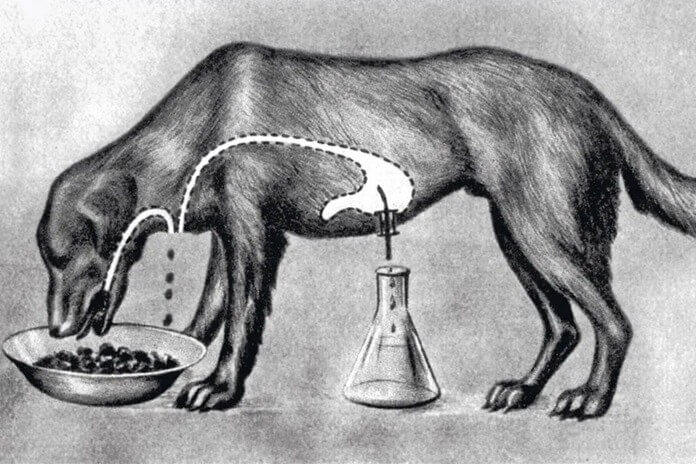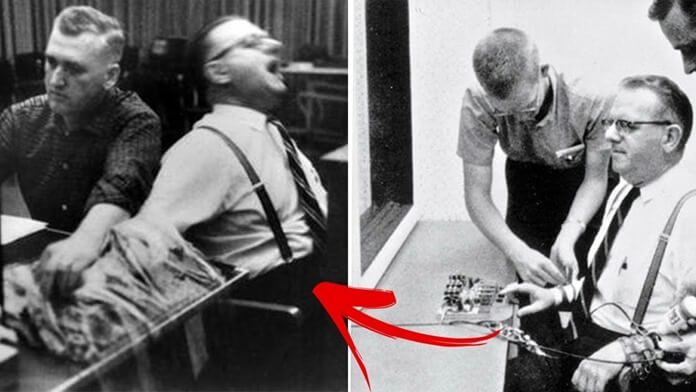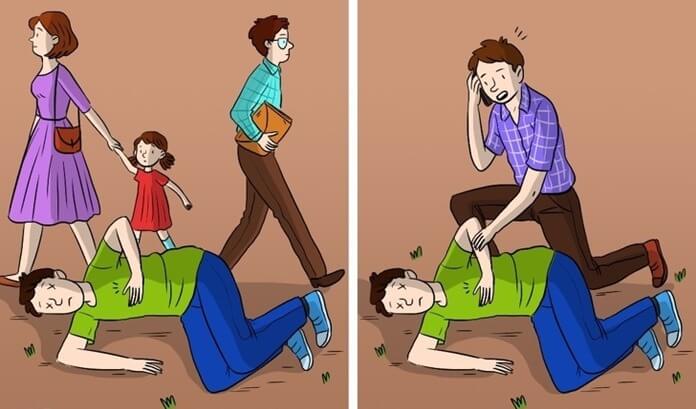Why do people do what they do? Is it possible to deliberately instill in a person different feelings? Over the years, psychologists have studied these and other questions through experiments.
Although some of these studies cannot be replicated today due to the violation of ethical boundaries, this does not detract from the significance of their findings. Here are the top 10 most famous psychological experiments in history.
10. Experiments with "Pavlov's dog", 1904
 There is hardly a person in Russia who, at least out of the corner of his ear, has not heard about the experiments of the scientist Ivan Pavlov. Some consider them sadistic, while others emphasize that the discovery of conditioned and unconditioned reflexes advanced both physiology and psychology.
There is hardly a person in Russia who, at least out of the corner of his ear, has not heard about the experiments of the scientist Ivan Pavlov. Some consider them sadistic, while others emphasize that the discovery of conditioned and unconditioned reflexes advanced both physiology and psychology.
We will not give an emotional assessment of the scientist's activities and will tell you about the essence of his experiments.
- Through a hole (fistula) in the gastrointestinal tract of the animal, gastric juice was taken out, collected in a container, and its amount was estimated.
- A light signal was given and at the same time the dog was offered food. At this time, her saliva was secreted, and gastric juice entered through the fistula.
- After a while, the signal was given as before, but the food was no longer given. But the dog still produced saliva and gastric juice. This was a conditioned reflex to an external stimulus.
Conclusions: Pavlov's experiments made it possible to establish a close relationship between mental and physiological processes taking place in the body of living beings, including humans.
9. Experiment "Little Albert", 1920
For the experiment, conducted by Dr. John B. Watson, a nine-month-old toddler from the orphanage named "Albert B" was selected. He played with white fluffy objects (skein of yarn, white rabbit, tame white rat, etc.) and initially showed joy and affection for his toys.
Over time, when Albert played with these objects, Dr. Watson made a loud noise behind the child's back to scare him. After many trials, Albert began to fear one kind of white fluffy objects.
Research findings: a person can be "programmed" to fear or enjoy something.
8. Experiment to study conformism, 1951
 What do you do if you know you are right, but the rest of the group disagrees with you? Will you submit to group pressure or will you defend your point of view? These are the questions that psychologist Solomon Ash decided to answer.
What do you do if you know you are right, but the rest of the group disagrees with you? Will you submit to group pressure or will you defend your point of view? These are the questions that psychologist Solomon Ash decided to answer.
In his experiment, Ash selected 50 students to participate in a "vision test." Each of them was placed in his own group, shown 18 pairs of cards with vertical lines and asked to determine which of the three lines on the second card corresponds to the length of the line shown on the first card.
However, the participants in the experiment did not know that there were actors in the group with them, who sometimes deliberately gave the wrong answer.
It turned out that, on average, over 12 trials, almost a third of the participants in the experiment agreed with the wrong answer from the majority, and only 25 percent of the subjects never agreed with the wrong answer.
In the control group, which included only the participants in the experiment, and not the actors, there were less than 1% incorrect answers.
Asch's experiment showedthat most people will obey the opinion of the group, out of the belief that the group is better informed than the person himself.
7. Milgram's experiment, 1963
 Yale professor Stanley Milgram wanted to test whether people would obey commands even when it was against their conscience.
Yale professor Stanley Milgram wanted to test whether people would obey commands even when it was against their conscience.
The study participants were 40 men aged 20 to 50 years. They were divided into two groups - students and teachers. At the same time, the actors hired by Milgram were always chosen as students, and the unsuspecting subjects were always teachers.
- The student was tied to a chair with electrodes in one room, while the experimenter and teacher were in another.
- It was stated that the student had to memorize pairs of words from a long list, and the teacher had to check his memory, and in case of an incorrect answer, apply a current to the chair.
- The teacher believed the electric shocks ranged from mild to most life-threatening. In fact, a student who deliberately made mistakes did not receive electrical shocks.
When the student was wrong many times, and the teachers knew about the alleged severe pain they were causing, some refused to continue the experiment. However, after verbal persuasion of the experimenter, 65% of teachers returned to "work."
A theory emerged from Milgram's research, which assumes that people allow others to direct their actions because they believe that the authority figure is more qualified and will take responsibility for the outcome.
6. The Bobo Doll Experiment, 1965
 Using a Bobo doll, which is a life-size bowling pin-shaped toy, Stanford University professor Albert Bandura and his team tested whether children copied aggressive behavior from adults.
Using a Bobo doll, which is a life-size bowling pin-shaped toy, Stanford University professor Albert Bandura and his team tested whether children copied aggressive behavior from adults.
Bandura and two colleagues selected 36 boys and 36 girls between the ages of 3 and 6 and divided them into three groups of 24.
- One group observed adults behaving aggressively towards the Bobo doll (hitting it with a hammer, throwing it into the air, etc.)
- Another group was shown an adult playing with the Bobo doll in a non-aggressive manner.
- And the last group was not shown a model of behavior at all, only the Bobo doll.
After each session, the children were taken to a room with toys and studied how their play models changed. The experimenters noticed that children who observed aggressive adults tried to imitate their actions in games.
Research results showhow children learn behavior by observing other people.
5. Foot in the door, 1966
 This was the name of a series of experiments conducted at Stanford University by Jonathan Friedman and S. Fraser. They were attended by two groups of housewives, randomly selected.
This was the name of a series of experiments conducted at Stanford University by Jonathan Friedman and S. Fraser. They were attended by two groups of housewives, randomly selected.
- During a telephone conversation, each housewife from the first group was asked to answer several questions about the use of detergents (small request). Three days later, those who agreed to answer the questions were asked for a big concession: to allow a group of men to enter their home and take an inventory of their household items.
- The second group of women immediately received a large request without a previous small survey.
- More than half of the subjects from the first group who agreed to answer the small request also agreed with the "larger request." But from the second group, less than 25% agreed to a large request.
The foot-in-the-door experiment demonstratedthat a small concession made by a person increases the chance that he will agree to comply with further requests.
4.Learned Helplessness Experiment, 1967
 One of the most famous psychological experiments of all time was conducted by the American psychologist Martin Seligman. The test subjects were dogs, which were divided into three groups.
One of the most famous psychological experiments of all time was conducted by the American psychologist Martin Seligman. The test subjects were dogs, which were divided into three groups.
- Dogs from the first group received light electric shocks, but could stop the effect by pressing the panel with their nose.
- Dogs from the second group also received an electric shock, but its effect ceased only when a dog from the first group pressed the panel.
- Dogs in the third group did not receive electric shocks.
Then dogs from all three groups were placed in boxes with low partitions. By jumping over them, the animals could easily get rid of the electric shock. Dogs from the first and third groups did just that. However, the dogs from the second group simply lay down on the floor and whined.
The experiment showedthat some subjects will not try to get out of a negative situation because past experience has led them to believe that they are helpless.
3. The effect of the outsider (aka the bystander effect), 1968
 The idea for this experiment is rooted in the 1964 case of the rape and murder of Kitty Genovese in New York. The crime was watched by 38 people, but none of them intervened.
The idea for this experiment is rooted in the 1964 case of the rape and murder of Kitty Genovese in New York. The crime was watched by 38 people, but none of them intervened.
Researchers John Darley and Beebe Latane conducted 3 experiments in which subjects acted either alone or with a group of people. An emergency was played out in front of them (for example, the fall of an elderly woman), and psychologists watched whether the participants in the experiment would come to the rescue or not.
It turned outthat the more information (the victim's name, why he was in trouble, etc.) the “witness” receives, the higher the likelihood that he will come to the rescue. In addition, people may feel less responsible for intervening when there are many other people around. And if no one else reacts or takes action to help the victim, the situation is not perceived as an emergency.
2. Stanford Prison Experiment, 1971
 Stanford professor Philip Zimbardo selected 24 students for this world-famous psychological experiment, who were assigned either prisoners or guards.
Stanford professor Philip Zimbardo selected 24 students for this world-famous psychological experiment, who were assigned either prisoners or guards.
- The prisoners were kept in a makeshift prison set up in the basement of the Stanford psychology department.
- The guards "worked" an eight-hour shift, with wooden clubs and uniforms.
Both the guards and the inmates quickly adapted to their roles; but the experiment had to be interrupted after 6 days because it became too dangerous. Every third "guard" began to show sadistic inclinations, and people who played the role of prisoners were morally depressed.
“We realized how ordinary people can be easily transformed from the good Dr. Jekyll to the evil Mr. Hyde," Zimbardo wrote.
What the experiment showed: the behavior of people will fully correspond to the social roles imposed on them.
1. Experiment on Facebook, 2012
 Not all of the most famous psychological experiments are the brainchild of the last century. Some of them were held quite recently and you may have participated in one of them. An example is an experiment conducted on the social network Facebook in 2012.
Not all of the most famous psychological experiments are the brainchild of the last century. Some of them were held quite recently and you may have participated in one of them. An example is an experiment conducted on the social network Facebook in 2012.
About 700,000 Facebook users quietly took part in psychological tests so that researchers could see the impact of emotionally charged posts on the likes and statuses they posted.
The details of the experiment were revealed in a scientific article, and it turned out that the social network for a week showed hundreds of thousands of users only negative or only positive news in the feed.
Why research is useful: it turned out that users of social networks are susceptible to "emotional contamination", due to which they imitate the emotional response of other people.

